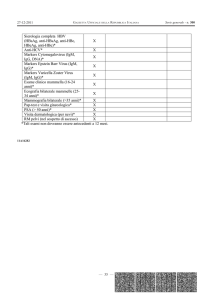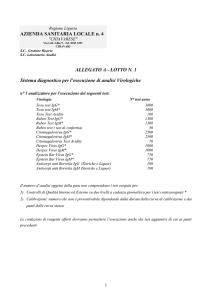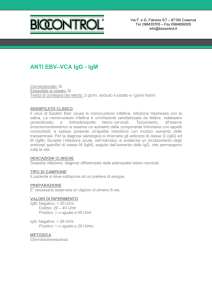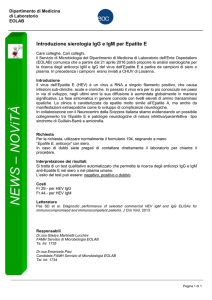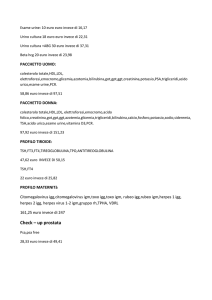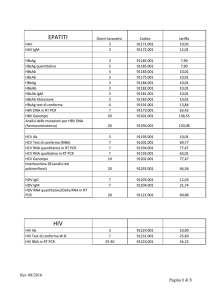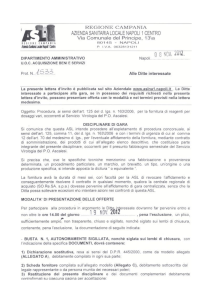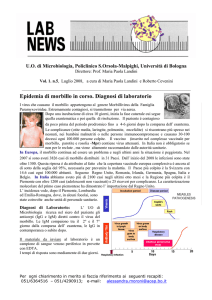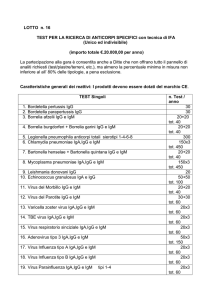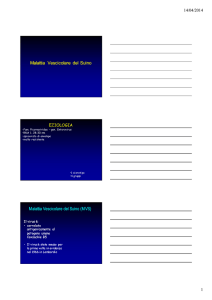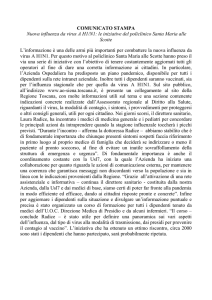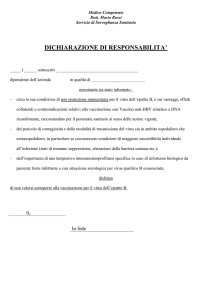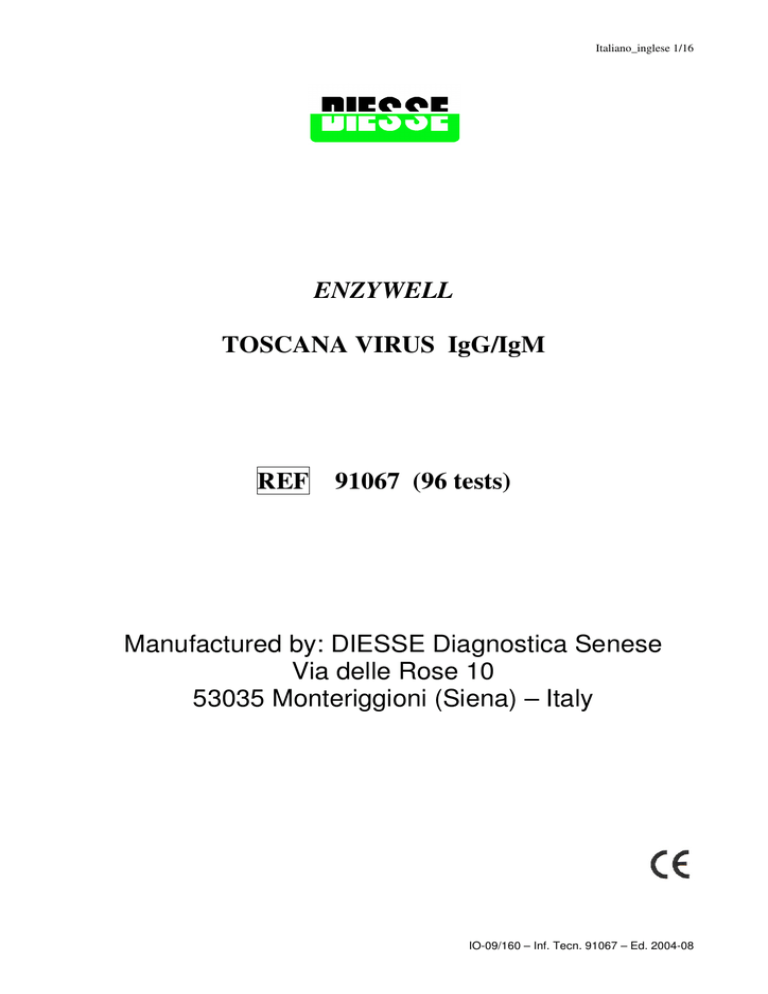
Italiano_inglese 1/16
ENZYWELL
TOSCANA VIRUS IgG/IgM
REF
91067 (96 tests)
Manufactured by: DIESSE Diagnostica Senese
Via delle Rose 10
53035 Monteriggioni (Siena) – Italy
IO-09/160 – Inf. Tecn. 91067 – Ed. 2004-08
Italiano_inglese 2/16
INDICE / INDEX
Section
1.
UTILIZZAZIONE / INTENDED USE / UTILISATION
2.
INTRODUZIONE / SUMMARY AND EXPLANATION OF TEST /INTERET CLINIQUE
3.
PRINCIPIO DEL METODO / PRINCIPLE OF THE TEST / PRINCIPE
4.
COMPOSIZIONE DEL KIT E PREPARAZIONE DEI REAGENTI / KIT CONTENTS AND
REAGENT PREPARATION / CONTENU DU COFFRET ET PREPARATOIN DES
REACTIFS
5.
MODALITA’ DI CONSERVAZIONE E STABILITA’ DEI REAGENTI / STORAGE AND
STABILITY OF REAGENTS / MODALITE DE CONSERVATION ET STABILITE DES
REACTIFS
6.
PRECAUZIONI / PRECAUTIONS / PRECAUTIONS D’UTILISATION
7.
TIPO DI CAMPIONE E CONSERVAZIONE / TYPE AND STORAGE OF SAMPLE /
TYPE D’ECHANTILLON
8.
PROCEDIMENTO / TEST PROCEDURE / MODE OPERATOIRE
9.
SCHEMA DEL SAGGIO / SCHEME OF TEST PROCEDURE / SCHEMA D’ANALYSE
10.
VALIDAZIONE DEL TEST / TEST VALIDATION / VALIDATION DU TEST
11.
INTERPRETAZIONE DEL TEST / INTERPRETATION OF RESULTS /
INTERPRETATION DES RESULTATS
12.
LIMITAZIONI DELLA PROCEDURA /LIMITATIONS OF THE PROCEDURE / LIMITES
DE LA METHODE
13.
SPECIFICITA’ ANALITICA / ANALYTICAL SPECIFICITY / SPECIFICITE
ANALYTIQUE
14.
SENSIBILITA’ E SPECIFICITA’ DIAGNOSTICA / DIAGNOSTIC SENSITIVITY AND
SPECIFICITY / SENSIBLITE ET SPECIFICITE DIAGNOSTIQUE
15.
PRECISIONE / PRECISION
16.
GUIDA DEI PROBLEMI DI UTILIZZO / “TROUBLE SHOOTING”
17.
BIBLIOGRAFIA / REFERENCES / BIBLIOGRAPHIE
IO-09/160 – Inf. Tecn. 91067 – Ed. 2004-08
Italiano_ 3/16
ISTRUZIONI PER L’USO
ENZYWELL
TOSCANA VIRUS IgG/IgM
REF 91067
1.
UTILIZZAZIONE:
METODO IMMUNOENZIMATICO PER LA DETERMINAZIONE QUALITATIVA DEGLI ANTICORPI IgG
ED IgM ANTI TOSCANA VIRUS NEL SIERO UMANO.
2.
INTRODUZIONE:
Il virus Toscana, appartenente al genere Phlebovirus della famiglia Bunyaviridae, è stato isolato per la prima volta in Italia
nel 1971. Da allora è stata accertata la sua presenza nell'area mediterranea ed è stato dimostrato il suo ruolo come agente
eziologico di malattia umana. La malattia causata dal Virus Toscana è caratterizzata da febbre, forte mal di testa e
meningite o meningoencefalite. L'infezione è trasmessa da insetti ematofagi del genere Phlebotomus e, a causa del ciclo
vitale del vettore, ha un andamento stagionale, con un picco nei mesi estivi. Dati epidemiologici suggeriscono che, nelle
zone dove il virus Toscana è endemico, una gran parte e forse la maggioranza delle meningiti asettiche nel periodo estivo
possono essere causate da questo virus. Sino ad oggi la diagnosi di infezione con Virus Toscana è stata prevalentemente
sierologica. Gli anticorpi specifici della classe IgM sono presenti nella fase acuta della malattia, mentre la presenza di
anticorpi specifici della classe IgG, in assenza di IgM, indica un'infezione pregressa. Tutti i metodi sierologici impiegati
finora hanno in comune la necessità di propagare il virus in colture cellulari, necessitando così di laboratori specializzati e
precludendo la diagnosi di infezione alla maggior parte dei laboratori di sierologia. Poiché è stato dimostrato che la
nucleoproteina virale è il bersaglio principale degli anticorpi anti-Virus Toscana, questa è stata espressa mediante la
tecnologia del DNA ricombinante in E. coli e utilizzata per realizzare un kit immunoenzimatico per la ricerca di IgG e IgM
specifiche al fine di facilitare l'indagine sierologica su questo virus.
3.
PRINCIPIO DEL METODO:
Il test è basato sul principio ELISA (Enzyme linked Immunosorbent Assay).
La determinazione delle IgG avviene dopo incubazione del siero in esame con una fase solida presensibilizzata con la
nucleoproteina ricombinante del virus Toscana altamente purificata. Le IgG specifiche si legano sulla fase solida e vengono
rivelate per ulteriore incubazione con un Mab di topo anti-IgG umane coniugato con Perossidasi.
La determinazione delle IgM avviene con il metodo "a cattura". Le IgM totali presenti nel siero si legano alla fase solida
sensibilizzata con un monoclonale di topo anti-IgM umane. Dopo il lavaggio si aggiunge un complesso formato dalla
nucleoproteina ricombinante del virus Toscana biotinilata e il coniugato Streptavidina-perossidasi.
In entrambi i casi l'intero complesso (per le IgG: IgG specifiche anti-virus Toscana con anti-IgG marcate con POD; per le
IgM: IgM-nucleoproteina-biotina/Streptavidina-perossidasi) viene determinato per addizione del substrato che assume una
colorazione blue in presenza di perossidasi. La colorazione stabile gialla è ottenuta per addizione di una soluzione
bloccante.
COMPOSIZIONE DEL KIT E PREPARAZIONE DEI REAGENTI
N.B. Il presente kit contiene tutti i reattivi necessari per il dosaggio sia delle IgG che per le IgM. I due tipi di
dosaggio vengono eseguiti separatamente.
-
I reagenti sono sufficienti per 2 x 48 determinazioni.
Portare a temperatura ambiente prima dell'uso.
Per le IgG
IgG MT PLATE MICROPIASTRA. 3 x 2 strips sensibilizzate con la nucleoproteina del Virus Toscana (ricombinante)
per la determinazione delle IgG.
Uso: Aprire l'involucro della piastra dalla parte opposta del codice (TV-G seguito dal numero di lotto) che serve per la sua
identificazione; prendere il supporto e gli strips necessari. Riporre gli altri non utilizzati nella busta di politene con il gel di
silice; fare uscire l'aria e sigillare premendo sulla chiusura.
IgG CONTROL + CONTROLLO POSITIVO (1.6 mL)
Contenuto: Siero umano diluito, a concentrazione nota di anticorpi IgG anti-Toscana virus, in tampone fosfato 0.01 mol/L
contenente BSA 1% e sodio azide 0,09%, liquido, pronto all'uso senza ulteriore diluizione.
IO-09/160 – Inf. Tecn. 91067 – Ed. 2004-08
Italiano_ 4/16
Colore: il colore è proporzionale al titolo anticorpale.
IgG CONTROL CUT OFF CONTROLLO CUT-OFF (2.0 mL)
Contenuto: Siero umano diluito, a concentrazione nota di anticorpi IgG anti-Toscana virus, in tampone fosfato 0.01
mol/L contenente BSA 1% e sodio azide 0,09%, liquido, pronto all'uso senza ulteriore diluizione.
Colore: il colore è proporzionale al titolo anticorpale.
IgG CONJ CONIUGATO IgG. 2 x 5 mL.
Contenuto: una soluzione di anticorpi monoclonali anti IgG umane marcati con perossidasi in tampone fosfato contenente
fenolo 0,05% e Bronidox 0,02%. Pronto all'uso senza ulteriore diluizione.
Per le IgM
IgM MT PLATE
MICROPIASTRA. 3 x 2 strips sensibilizzate con anticorpi monoclonali anti-IgM umane, per la
determinazione delle IgM.
Uso: Aprire l'involucro delle strips dalla parte opposta al codice (M, seguita dal numero di lotto) che serve per la sua
identificazione; prendere il supporto ed inserire i pozzetti necessari. Riporre gli altri non utilizzati nella busta di politene
con il gel di silice; fare uscire l'aria e sigillare premendo sulla chiusura.
IgM CONTROL + CONTROLLO POSITIVO (1.6 mL)
Contenuto: Siero umano diluito, a concentrazione nota di anticorpi IgM anti-Toscana virus, in tampone fosfato 0.01
mol/L contenente BSA 1% e sodio azide 0,09%, liquido, pronto all'uso senza ulteriore diluizione.
Colore: il colore è proporzionale al titolo anticorpale.
IgM CONTROL CUT OFF CONTROLLO CUT-OFF (2.0 mL)
Contenuto: Siero umano diluito, a concentrazione nota di anticorpi IgM anti-Toscana virus, in tampone fosfato 0.01
mol/L contenente BSA 1% e sodio azide 0,09%, liquido, pronto all'uso senza ulteriore diluizione.
Colore: il colore è proporzionale al titolo anticorpale.
Ag ANTIGENE. Liofilo x 6 fiale.
Contenuto: Antigene ricombinante del Virus Toscana legato a biotina in tampone fosfato contenente lattosio.
Preparazione: ricostituire con il volume di coniugato indicato in etichetta.
IgM CONJ CONIUGATO IgM. 2 x 5 mL.
Contenuto: Streptavidina coniugata con perossidasi, in soluzione tampone. Pronto all'uso senza ulteriore diluizione.
L'immunocomplesso deve essere preparato 45 minuti circa prima dell'uso.
- Reagenti comuni ai due dosaggi
CONTROL - IgG/IgM CONTROLLO NEGATIVO. 1 x 1.6 mL. INTERCAMBIABILE FRA LOTTI
Contenuto: Siero umano, privo di anticorpi IgG ed IgM, diluito in tampone fosfato 0.01 mol/L contenente BSA 1% e sodio
azide 0,09%, liquido, pronto all'uso senza ulteriore diluizione.
WASH BUF 10x TAMPONE DI LAVAGGIO 10X (PF93603). 1 x 100 mL. INTERCAMBIABILE FRA LOTTI
Contenuto: Soluzione salina tamponata (PBS) concentrata 10 volte contenente Brij 0.5% .
Preparazione: Diluire il volume richiesto 1:10 con acqua distillata per ottenere il tampone di lavaggio pronto all'uso. Se
sono presenti cristalli, discioglierli a 37°C prima di diluire.
SAMP DIL 10x. DILUENTE 10X (PF93612). 1 x 15 mL. INTERCAMBIABILE FRA LOTTI
Da utilizzare per la diluizione dei campioni.
Contenuto: Soluzione proteica concentrata 50x, con fenolo 0,05% e Bronidox 0,02%.
Preparazione: Diluire il volume richiesto 1:10 nel tampone di lavaggio per avere il diluente pronto all'uso.
SUBS TMB SUBSTRATO (PF93619). 12 mL. Pronto all'uso. INTERCAMBIABILE FRA LOTTI
Contenuto: Tetrametilbenzidina 0,26 mg/mL ed H2O2 0,01% stabilizzati in tampone citrato 0,05 mol/L (pH 3,8).
H2SO4 0.3 M SOLUZIONE BLOCCANTE (PF93602). 1 x 16 mL. INTERCAMBIABILE FRA LOTTI
Soluzione di H2SO4 0,3 mol/L pronta all'uso.
PELLICOLA PROTETTIVA (2).
BUSTA DI POLIETILENE (1).
ALTRO MATERIALE RICHIESTO, MA NON FORNITO.
• Incubatore a 37°C
IO-09/160 – Inf. Tecn. 91067 – Ed. 2004-08
•
•
•
•
•
•
•
•
•
•
Italiano_ 5/16
Lettore di micropiastre(lunghezza d'onda 450 o 450/620 nm, con linearità fino ad OD >= 2,000)
Lavatore di micropiastre (non indispensabile) capace di dispensare volumi compresi tra 225-375 µl
Acqua distillata o deionizzata
Normale vetreria di laboratorio: cilindri, provette, ecc.
Micropipette capaci di prelevare accuratamente 10,.100,.1000 µl di soluzione
Guanti mono-uso
Contaminuti
Soluzione al 5% di sodio ipoclorito
Contenitori per la raccolta di materiali potenzialmente infetti
Carta assorbente
5.
MODALITA’ DI CONSERVAZIONE E STABILITA’ DEI REAGENTI
I reagenti devono essere conservati a 2/8°C.
La data di scadenza è stampata su ogni componente e sull’etichetta esterna della confezione.
I Reagenti hanno una stabilità limitata dopo apertura e/o preparazione:
REAGENTE
CONDIZIONI
MICROPIASTRA IgG e IgM
5 settimane 2/8°C busta di polietilene
CONTROLLI
5 settimane 2/8°C
CONIUGATO IgG
5 settimane 2/8°C
CONIUGATO IgM
5 settimane 2/8°C
ANTIGENE RICOSTITUITO
la soluzione non è conservabile e deve essere utilizzata dopo la ricostituzione
SUBSTRATO
fino alla scadenza a 2/8°C, 1 settimana ; 15/30°C al buio
DILUENTE CAMPIONI
p.uso 2 settimane 2/8°C
WASH BUFFER
p.uso 2 settimane 2/8°C, 5 gg 15/30 °C
STOP SOLUTION
fino alla scadenza a 2/8°C
6.
PRECAUZIONI:
SOLO PER USO DIAGNOSTICO IN VITRO.
Attenzione:
Questo kit contiene materiali di origine umana che sono stati testati e trovati negativi con test approvati dall’FDA sia
per la ricerca di HbsAg che per quella degli anticorpi anti-HIV-1, anti-HIV-2 ed anti-HCV.. Poiché nessun test
diagnostico può offrire una completa garanzia sull'assenza di agenti infettivi, qualunque materiale di origine umana
deve essere considerato potenzialmente infetto. Tutti i reagenti e i campioni devono essere maneggiati secondo le norme
di sicurezza normalmente adottate in laboratorio.
Avvertenze per la sicurezza personale
1. Non pipettare con la bocca. Usare guanti monouso e protezione per gli occhi nel maneggiare i campioni e durante la
prova. Lavare accuratamente le mani una volta terminato il test.
2. I seguenti reagenti contengono concentrazioni basse di sostanze dannose o irritanti:
a) Il tampone di lavaggio contiene detergenti
b) Il coniugato contiene fenolo
c) Il substrato è acido
d) I controlli contengono Sodio Azide (0.09%) che, con piombo e rame può formare depositi altamente esplosivi
di metallo azidi: diluire con molta acqua per la sua eliminazione
Se un reagente viene a contatto con la pelle o con gli occhi, lavare abbondantemente con acqua.
3. Le apparecchiature non disposable devono essere sterilizzate dopo l'uso, ponendo preferibilmente in autoclave per 1 h
a 121°C; i disposables devono essere autoclavati o inceneriti.
4. L'acido solforico contenuto nello Stop Solution e l'acido cloridrico usato per lavare la vetreria sono corrosivi; tali
sostanze devono essere adoperate con cautela. In caso di contatto con la pelle o gli occhi, lavare abbondantemente con
acqua.
5. Acidi neutralizzati ed altri rifiuti liquidi devono essere disinfettati aggiungendo sodio ipoclorito in un volume
sufficiente da ottenere una concentrazione finale almeno dell'1%. Un'esposizione al sodio ipoclorito all'1% per 30
minuti dovrebbe essere sufficiente per garantire una disinfezione efficace.
6. Eventuali versamenti di materiali potenzialmente infetti devono essere rimossi immediatamente con carta assorbente e
la zona inquinata dovrà essere pulito, per esempio con sodio ipoclorito all'1%, prima di proseguire il lavoro. Se è
presente un acido, il sodio ipoclorito non deve essere usato prima che la zona sia stata asciugata. Tutti i materiali
utilizzati per pulire eventuali versamenti accidentali, compresi guanti, devono essere scartati come rifiuti
potenzialmente infetti. Non mettere in autoclave materiali contenenti sodio ipoclorito.
Avvertenze analitiche
1. Prima dell'uso, portare tutti i reagenti ed i campioni a temperatura ambiente (18-30°C). Riporre i reagenti alla
temperatura di conservazione raccomandata immediatamente dopo l'uso. E'importante disporre di una corretta
IO-09/160 – Inf. Tecn. 91067 – Ed. 2004-08
Italiano_ 6/16
2.
3.
4.
5.
6.
7.
8.
9.
10.
11.
12.
13.
termostatazione per l'incubazione delle strip. Controllare che il termostato non scenda sotto i 35°C e non salga
oltre i 39°C.
Aprire la busta contenente le strip dopo almeno mezz'ora a temperatura ambiente.
Non utilizzare i reagenti dopo la data di scadenza. Evitare l'inquinamento microbico dei reagenti poiché ciò riduce la
validità del prodotto e può dare luogo a risultati errati.
Non modificare la Procedura, né sostituire i reagenti con quelli di altri produttori o da altri lotti, a meno che non sia
specificamente riportato che il reagente è intercambiabile fra lotti. Non ridurre i tempi di incubazione raccomandati.
Tutta la vetreria da utilizzare nel test deve essere lavata accuratamente con acido cloridrico 2M e sciacquata con acqua
distillata o deionizzata.
Non esporre i reagenti a forte illuminazione né a vapori di ipoclorito durante la conservazione e le fasi di incubazione.
Evitare che i pozzetti si secchino durante il test.
Evitare la contaminazione incrociata fra reagenti. E' importante adoperare delle pipette "dedicate" per l'uso.
Evitare di toccare il bordo del pozzetto con il coniugato. Non soffiare sulle micropiastre.
I dosaggi immunoenzimatici possono talvolta presentare un particolare effetto sul bordo ("edge effect"); si può
minimizzare tale effetto aumentando l'umidità durante le fasi di incubazione. Le piastre devono essere coperte con i
copripiastre ed incubate a 37°C o in bagnomaria usando un sostegno per le piastre, o in incubatore. In alternativa, le
piastre si possono incubare in un analizzatore adatto. Per ulteriori dettagli consultare l'apposito manuale operativo
dello strumento. Non si possono utilizzare incubatori a CO2.
Prima di leggere la piastra, assicurarsi che il fondo della piastra sia pulito ed asciutto e che non ci siano bolle d'aria
sulla superficie del liquido.
Può essere fonte di errori l'uso di campioni fortemente emolizzati, siero non completamente coagulato, o campioni che
presentano inquinamento microbico.
L’uso del kit con strumento automatici deve essere validato dall’utilizzatore.
Leggere il manuale operativo relativo a qualsiasi strumento utilizzato, ed in particolare con riferimento ai seguenti
punti:
- installazione e requisiti particolari
- principio operativo, istruzioni, precauzioni, rischi
- specifiche del produttore e performance dello strumento
- manutenzione e assistenza tecnica.
7.
TIPO DI CAMPIONE E CONSERVAZIONE
Il tipo di campione è rappresentato da siero ottenuto da sangue prelevato per normale venipuntura e maneggiato con
appropriati accorgimenti come richiesto nelle procedure standard di laboratorio. Il siero fresco può essere mantenuto per 4
giorni a 2/8°C per periodi maggiori a –20°C ,evitare cicli ripetuti di congelamento e scongelamento. . I campioni
scongelati devono essere agitati con cura prima del dosaggio. L’inattivazione al calore può fornire risultati erronei. La
qualità del campione può essere seriamente influenzata dalla contaminazione microbica che può portare a risultati erronei.
Campioni fortemente lipemici, itterici o inquinati non dovrebbero essere utilizzati. Se non è possibile il prelievo di un
campione fresco, i campioni dovrebbero essere chiarificati mediante filtrazione (0,45 µm) o centrifugazione (3000 rpm x
10').
Il test non è applicabile al plasma umano.
8. PROCEDIMENTO
- Preparare i pozzetti necessari.
- Preparare il tampone di lavaggio diluendo il Wash Buffer 10x (100 mL + 900 mL H2O).
- Preparare il diluente dei campioni aggiungendo il DILUENT 10x al tampone di lavaggio (5 mL + 45 mL).
- Preparare l'antigene ricostituendo il liofilo con il volume di coniugato indicato in etichetta.
Diluire i campioni 1:101 dispensando 10 µL di siero in 1 mL di diluente, distribuire 100 µL di ciascun campione diluito,
per pozzetto (è preferibile effettuare l'analisi in duplicato). In uno strip porre i controlli NON DILUITI (100 µL per
pozzetto). Il requisito minimo indispensabile è di 1 controllo negativo, 2 cut-off e 1 positivo. Prevedere un pozzetto libero
per effettuare il bianco usando solo 100 µL della miscela substrato.
Si coprono i pozzetti con la pellicola protettiva e si pone ad incubare per 45 min. a 37°C. Dopo 4 lavaggi della durata di 30
secondi ciascuno (300 µl) si aggiungono 100 µL del coniugato (anti-IgG per la determinazione delle IgG o complesso
antigene/coniugato per la determinazione delle IgM) per pozzetto e si pone di nuovo ad incubare per 45 min. a 37°C
coprendo i pozzetti con la pellicola protettiva. Si lava di nuovo la piastra per 4 volte come descritto sopra, quindi si
distribuisce il Substrato, 100 µL/pozzetto. Dopo 15 min. a temperatura ambiente si blocca la reazione enzimatica con 100
µL di Stop Solution. Si legge la Assorbanza (O.D.) a 450 nm o 450/620 nm entro 30 min.
9.
Schema del protocollo di prova per Toscana Virus IgG/IgM
STEP 1
Mettere 100 µL di siero diluito /controlli nei pozzetti
IO-09/160 – Inf. Tecn. 91067 – Ed. 2004-08
Italiano_ 7/16
incubare 45 min. a 37°C
lavare 4 volte (300 µl)
STEP 2
Mettere 100 µL di coniugato (anti-IgG per la determinazione delle IgG; complesso
antigene/coniugato per la determinazione delle IgM) per pozzetto
incubare 45 min. a 37°C
lavare 4 volte (300 µl)
STEP 3
mettere 100 µL di Substrato per pozzetto
incubare 15 min. a t.a.
STEP 4
aggiungere 100 µL di Stop Solution
leggere l'O.D. a 450 nm entro 30 min.
10.
VALIDAZIONE DEL TEST
Togliere il valore del bianco (<= 0.150) a tutte le altre letture. I valori in O.D. del siero di controllo Cut-off devono essere
entro il 25% del valore medio. Scartare eventualmente il valore aberrante e ricalcolare la media. Il positivo deve avere O.D.
pari almeno a 1.5 volte il Cut-off. Il rapporto fra Negativo e Cut-off deve essere inferiore a 0.6.
11.
INTERPRETAZIONE DEL TEST
Risultati qualitativi
Se il valore dell'assorbanza del campione è superiore al Cut-off il campione risulta positivo per la presenza di anticorpi
specifici per l'antigene.
Calcolare il rapporto (Index) fra il valore medio delle O.D. del campione in esame e quello del Cut-Off. Il campione sarà
giudicato:
Positivo: quando il rapporto è > 1.2.
Dubbio: = ± 20% del Cut-off.
Negativo: quando il rapporto è < 0.8.
In caso di risultato dubbio ripetere il test. Se il risultato rimane dubbio, ripetere il prelievo
12.
LIMITAZIONI DELLA PROCEDURA
Il risultato del test deve essere comunque valutato insieme a dati provenienti da altre indagini diagnostiche.
13. SPECIFICITA’ ANALITICA
Non sono da escludere cross reazioni da altri serotipi correlati del genere Phlebovirus come Sicilia e Naples.
14. SENSIBILITA’ E SPECIFICITA’ DIAGNOSTICA
Sono stati testati 97 sieri di pazienti appartenenti ai seguenti 3 gruppi:
1- 22 sieri di pazienti con sintomi neurologici di meningite da Virus Toscana
2- 22 sieri di soggetti pediatrici
3- 53 sieri di pazienti provenienti dalla routine.
I campioni sono stati testati con il kit in oggetto ed i risultati sono stati confrontati con un sistema Elisa che utilizzava
l’antigene nativo. I casi discordanti ( 0 nella determinazione IgM e 10 nella determinazione delle IgG) sono stati analizzati
in Western Blotting.
I risultati ottenuti sono qui di seguito riassunti:
Toscana virus IgG :
Altro metodo
P
N
Diesse P
38
2
N
2
55
Sensibilità diagnostica 95.0% (IC al 95%: 83.5-98.6%)
Specificità diagnostica 96.5 % (IC al 95%: 88.1-99.0%)
IO-09/160 – Inf. Tecn. 91067 – Ed. 2004-08
Italiano_ 8/16
Toscana virus IgM
Altro metodo
P
N
Diesse P
19
0
N
0
78
Sensibilità diagnostica 100.% (IC al 95%: 83.2-100%)
Specificità diagnostica 100 % (IC al 95%: 95.3-100%)
15. PRECISIONE
Toscana virus IgG
Tab.1 Precisione nella prova (12 repliche del Cut Off in tre lotti differenti)
O.D.
Lot. N. 36
37
38
Cut Off n=12
0.384
0.234
0.386
CV%
8
11
6
Tab.2
Precisione tra prove (media dell’Index in tre lotti differenti)
Lotti
036
037
campione
1
0.79
0.65
2
1.74
1.36
3
2.4
3.2
038
average
cv%
0.5
1
2.5
0.65
1.55
2.7
22
17
16
Toscana Virus IgM
Tab.3 Precisione nella prova (12 repliche del Cut Off in tre lotti differenti
O.D.
Cut Off n=12
CV%
Lot. N. 36
0.235
5
37
0.245
5
38
0.387
9
Tab.4 Precisione tra prove (media dell’Index in tre lotti differenti)
Lotti
036
037
Sample
1
0.68
0.59
2
1.46
2.08
3
2.95
5.1
16.
038
average
0.35
1.32
3.23
0.54
1.62
3.76
cv%
32
25
32
GUIDA DEI PROBLEMI DI UTILIZZO
PROBLEMA
Seduta invalida (tutti negativi)
POSSIBLI FONTI DI ERRORE
Uno o più reagenti non sono stati
aggiunti oppure sono stati aggiunti
in ordine errato
Piastra non reattiva
Seduta invalida (tutti positivi)
Inquinamento del substrato
Lavaggio inadeguato
Scarsa precisione
Aspirazione inadeguata dei pozzetti
Errore del pipettamento
Aggiunta dei reagenti troppo lenta
AZIONI DA INTRAPRENDERE
Controllare nuovamente la procedura.
Controllare se qualche reagente non è stato
aggiunto.
Ripetere il test.
Controllare il codice sulla busta della piastra
(vedi istruzioni per l’uso punto 4 per il
codice corretto).
Controllare la presenza di umidità nella
piastra inutilizzata. (Il gel di silice deve
essere giallo pallido) Ripetere il test.
Prelevare una nuova aliquota del substrato.
Assicurarsi del buon funzionamento del
lavatore
Assicurarsi del buon funzionamento del
lavatore
Controllare il funzionamento della pipetta
Evitare l’essiccamento della piastra dopo il
IO-09/160 – Inf. Tecn. 91067 – Ed. 2004-08
Italiano_ 9/16
Insufficiente sviluppo di colore
17.
1.
2.
3.
4.
lavaggio. Aggiungere i reattivi
immediatamente.
Presenza di bolle d’aria
Evitare la formazione di bolle d’aria durante
il pipettamento
Percorso ottico non limpido
Controllare la fonte luminosa per la presenza
di sporco. Pulire il fondo della piastra con
fazzoletto di carta.
Tempo o temperatura di incubazione Verificare il monitoraggio della temperatura
non corretto
ed il tempo di incubazione
Seguire attentamente le istruzioni per l’uso.
Substrato aggiunto in volume
Controllare il funzionamento della pipetta.
inadeguato
BIBLIOGRAFIA
Nicoletti L. et al. 1991. Central Nervous Systen involvement during infection by Phlebovirus Toscana of residents
in
natural foci in Central Italy (1977-1988). Am. J. Trop. Med. Hyg. 45, 429-434.
Schwarz et al. 1996. Immunoblot detection of antibodies to Toscana Virus. J. Medical Virology 49, 83-86.
Valassina M. et al. 1998. Diagnostic potential of Toscana virus in protein expresed in Escherichia coli. J. Clin.
Microbiol. 36, 3170-3172.
Soldateschi D. et al. 1999. Laboratory diagnosis of Toscana virus infection by enzyme immunoassay with
recombinant viral nucleoprotein. J. Clin. Microbiol. 37, 649-652.
DIESSE Diagnostica Senese
Via delle Rose 10
53035 Monteriggioni (Siena) Italy.
Tel. 0577-587111
IO-09/160 – Inf. Tecn. 91067 – Ed. 2004-08
Inglese_ 10/16
INSTRUCTIONS FOR USE
ENZYWELL
SAND-FLY FEVER IgG/IgM
REF
91067
1.
INTENDED USE:
IMMUNOENZYMATIC METHOD FOR THE QUALITATIVE DETERMINATION OF IgG AND IgM
ANTIBODIES TO TOSCANA VIRUS IN HUMAN SERUM
2.
SUMMARY AND EXPLANATION OF THE TEST:
The Toscana Virus, belonging to the Phlebovirus genus of the Bunyaviridiae family, was isolated for the first time in
Italy in 1971. Since then, its presence in the mediterranean area has been established and its role as an etiological agent
in human disease has been demonstrated. The disease caused by Toscana Virus is characterized by fever, strong
headache and meningitis or meningoencephalitis. The infection is transmitted by hematophagous insects of the
Phlebotomus genus and is seasonal with a peak in the summer months, due to the life cycle of the vector.
Epidemiological data indicate that in areas where the Toscana Virus is endemic, many, perhaps the majority of cases of
aseptic meningitis during the summer period are caused by this virus. Until now, the diagnosis of Toscana virus
infection has been mainly performed serologically. Specific antibodies of the IgM class are present during the acute
phase, while the presence of specific IgG antibodies in the absence of IgM indicates a previous infection. All the
serological methods adopted up to the present time require propagation of the virus in cell cultures; these methods can
only be performed in specialized laboratories, while the infection canno tbe diagnosed in the majority of s erological
laboratories. As it has been shown that the viral nucleoprotein is the chief target of the anti-Toscana virus antibodies,
this has been expressed by recombinant DNA technology in E. coli and used to set up an immunoenzymatic kit for the
detection of specific IgG and IgM, as an aid in the serological study of this virus.
3.
PRINCIPLE OF THE TEST:
The test is based on the ELISA technique (Enzyme linked Immunosorbent Assay).
Determination fo the IgG is performed after incubation of the serum sample with a solid phase precoated with the
highly purified recombinant nucleoprotein of the Toscana virus. Specific igG bind to the solid phase and are detected
buy further incubation with a mouse anti-human IgG monoclonal antibody conjugated with peroxidase.
The IgM are detected by the capture method. The total igM present in the serum bind to the solid phase precoated with
a mouse anti-human IgM monoclonal antibody. After washing, a complex composed of the biotinylated recombinant
nucleoprotein of Toscana virus and the S treptavidin-peroxidase conjugate.
In both cases, the whole complex (for the IgG: specific IgG anti-Toscana virus with anti-IgG labelled with POD; for the
IgM: IgM-nucleoprotein-biotin/Streptavidin-peroxidase) is determined by the addition of the substrate which becomes
blue coloured in the presence of peroxidase. A stable yellow colour is obtained by addition of a blocking solution.
4.
KIT CONTENTS AND REAGENT PREPARATION:
N.B. The present kit contains all the reagents necessary for the assay of both IgG and IgM. The two types of
assay must be performed separately.
- Reagents are sufficient for 2 x 48 determinations.
- Bring to room temperature before use.
For the IgG
IgG MT PLATE MICROPLATE. 3 x 2 strips coated with the recombinant nucleoprotein of Toscana virus for the
determination of IgG.
Use: open the package on the opposite side from the code (M followed by the lot number) which is useful for
identification purposes, remove the support and strips to be used from the foil package, and place the unused strips in
the polythene bag with the silica gel, expel the air and seal by pressing the closure.
IgG CONTROL
+
POSITIVE CONTROL (1 x 1.6 mL)
IO-09/160 – Inf. Tecn. 91067 – Ed. 2004-08
Inglese_ 11/16
Contents: Diluted human serum containing a known amount of anti-Toscana virus IgG, in Phosphate buffer 0.01 mol/L
with BSA 1% and sodium azide 0.09%, liquid, ready for use without further dilution.
Colour: the colour of the controls is proportional to the relative antibody titer.
CONTROL CUT OFF
CUT OFF CONTROL (1 x 2.0 mL)
Contents: Diluted human serum containing a known amount of anti-Toscana virus IgG in Phosphate buffer 0.01 mol/L
with BSA 1% and sodium azide 0.09%, liquid, ready for use without further dilution.
Colour: the colour of the controls is proportional to the relative antibody titer.
IgG CONJ IgG CONJUGATE. 2 x 5 mL.
Contents: anti-human IgG monoclonal antibodies labelled with Peroxidase, in phosphate buffer solution containing
phenol 0.05% and Bronidox 0.02%. Ready for use without further dilution.
For the IgM
IgM MT PLATE
MICROPLATE. 3 x 2 strips coated with anti-human IgM monoclonal antibodies for the
determination of IgM.
Use: open the package on the opposite side from the code (M followed by the lot number) which is useful for
identification purposes, remove the support and strips to be used from the foil package, and place the unused strips in
the polythene bag with the silica gel, expel the air and seal by pressing the closure.
IgM CONTROL +
POSITIVE CONTROL (1 x 1.6 mL)
Contents: Diluted human serum containing a known amount of anti-Toscana virus IgM, in Phosphate buffer 0.01 mol/L
with BSA 1% and sodium azide 0.09%, liquid, ready for use without further dilution.
Colour: the colour of the controls is proportional to the relative antibody titer.
IgM CONTROL CUT OFF
CUT OFF CONTROL (1 x 2.5 mL)
Contents: Diluted human serum containing a known amount of anti-Toscana virus IgM in Phosphate buffer 0.01 mol/L
with BSA 1% and sodium azide 0.09%, liquid, ready for use without further dilution.
Colour: the colour of the controls is proportional to the relative antibody titer.
Ag ANTIGEN. Freeze-dried x 6 vials.
Contents: Recombinant antigen of the Toscana virus linked to biotin in phosphate buffer containing lactose.
Preparation: reconstitute with the volume of conjugate reported on the label.
IgM CONJ IgM CONJUGATE. 2 x 5 mL.
Contents: streptavidin conjugated to peroxidase in buffer solution. Ready for use without further dilution.
Stability: The unopened product is stable up to the expiry date. The immunocomplex must be prepared 45 minutes
before use.
Reagents used in both assays
CONTROL IgG/ IgM NEGATIVE CONTROL (PF93900) (1 x 1.6 mL) INTERCHANGEABLE BETWEEN
LOTS
Contents: Diluted human serum in Phosphate buffer 0.01 mol/L with BSA 1% and sodium azide 0.09%, liquid, ready
for use without further dilution.
WASH BUF 10x WASH BUFFER 10X (PF93603). 1 x 100 mL. INTERCHANGEABLE BETWEEN LOTS
Contents: Phosphate buffered saline, concentrated 10 times; contains Brij 0.5% .
Preparation: dilute the required volume 1:10 with distilled water in order to obtain the washing buffer ready for use. If
crystals are present, they should be dissolved at 37°C before dilution.
SAMP DIL
10x
DILUENT 50X (PF93612). 1x15 mL. For dilution of serum samples.
INTERCHANGEABLE BETWEEN LOTS
Contents: Proteic solution concentrated 10 times, with added phenol 0.05% and Bronidox 0.02%.
Preparation: Dilute the required volume 1:50 in the washing buffer to obtain the diluent ready for use.
SUBS TMB SUBSTRATE (PF93619). 12 mL. Ready for use. INTERCHANGEABLE BETWEEN LOTS
Contents: Tetramethylbenzidine 0.26 mg/mL and hydrogen peroxide 0.01% stabilised in citrate buffer 0.05 mol/L (pH
3.8).
IO-09/160 – Inf. Tecn. 91067 – Ed. 2004-08
Inglese_ 12/16
H2SO4 0.3 M STOP SOLUTION (PF93602). 1x16 mL. INTERCHANGEABLE BETWEEN LOTS
H2SO4 0.3 mol/L, in solution ready for use.
ADHESIVE FILMS (2).
POLYTHENE BAG (1).
MATERIALS REQUIRED BUT NOT PROVIDED.
- Incubator at 37°C
- Microplate reader (wave length 450 or 450/620 nm, with linearity up to OD >= 2000)
- Microplate washer (preferable) able to dispense volumes in the range 225-375 µL
- Distilled or deionised water
- Normal laboratory glassware: cylinders, test-tubes etc.
- Micropipettes for the accurate collection of 10, 100, 1000 µl solution
Disposable gloves
Timer
Sodium Hypochlorite solution (5%)
Containers for collection of potentially infectious materials
Absorbent tissue.
5.
STORAGE AND STABILITY OF REAGENTS
Reagents must be stored at 2/8°C.
The expiry date is printed on each component and on the box label.
Reagents have a limited stability after opening and/or preparation
REAGENT
CONDITIONS
Microplate IgG and IgM
5 weeks at 2/8°C, polythene bag
Controls
5 weeks at 2/8°C
Conjugate IgG
5 weeks at 2/8°C
Conjugate IgM
5 weeks at 2/8°C
Reconstituted antigen
the solution cannot be stored and must be used immediately after reconstitution
Substrate
until the expiry date at 2/8°C, 1 week at 15-30°C in the dark
Sample Diluent
ready for use, 2 weeks at 2/8°C
Wash Buffer
2 weeks at 2/8°C, 5 days at 15/30°C.
Stop Solution
until the expiry date at 2/8°C
6.
PRECAUTIONS
FOR IN VITRO DIAGNOSTIC USE ONLY.
Caution: This kit contains materials of human origin which have been tested and gave a negative response by
FDA-approved methods for the presence of HbsAg and for anti-HIV-1, anti-HIV-2 and anti-HCV antibodies. As no
diagnostic test can offer a complete guarantee regarding the absence of infective agents, all material of human
origin must be handled as potentially infectious. All precautions normally adopted in laboratory practice should be
followed when handling material of human origin.
Health and Safety Information
1. Do not pipette by mouth. Wear disposable gloves and eye protection while handling specimens and performing the
assay. Wash hands thoroughly when finished.
2. The following reagents contain low concentrations of harmful or irritant substances:
a) The Wash Buffer contains detergents
b) The conjugate contains phenol
c) The substrate is acid
d) The controls contain 0.09% Sodium Azide which can react with lead and copper in plumbing forming
highly explosive deposits of metal azides; dilute with large amounts of water to eliminate.
If any of the reagents come into contact with the skin or eyes, wash the area extensively with water.
3. Non-disposable apparatus should be sterilized after use. The preferred method is to autoclave for 1 h at 121°C;
disposables should be autoclaved or incinerated.
IO-09/160 – Inf. Tecn. 91067 – Ed. 2004-08
Inglese_ 13/16
4.
5.
6.
Sulphuric acid required for the Stop Soution and hydrochloric acid used for washing glassware are corrosive and
should be handled with appropriate care. If they come into contact with the skin or eyes, wash thoroughly with
water.
Neutralized acids and other liquid waste should be decontaminated by adding a sufficient volume of sodium
hypochlorite to obtain a final concentration of at least 1.0%. A 30 minute exposure to 1% sodium hypochlorite
may be necessary to ensure effective decontamination.
Spillage of potentially infectious materials should be removed immediately with adsorbent paper tissue and the
contaminated area swabbed with, for example, 1.0% sodium hypochlorite before work is continued. Sodium
hypochlorite should not be used on acid-containing spills unless the spill area is first wiped dry. Materials used to
clean spills, including gloves, should be disposed of as potentially biohazardous waste. Do not autoclave materials
containing sodium hypochlorite.
Analytical precautions
1. Allow all reagents and samples to come to room temperature (18-30°C) before use. Immediately after use return
reagents to the recommended storage temperature. It is important to work at the correct temperature. Check
that the thermostat does not go below 35°C or over 39°C. Open the envelope containing the strips after at least
½ hr at room temperature.
2. Do not use the reagents beyond the stated expiry date. Microbiological contamination of reagents must be avoided
as this may reduce the life of the product and cause erroneous results.
3. Do not modify the Test Procedure or substitute reagents from other manufacturers or other lots unless the reagent
is stipulated as interchangeable. Do not reduce any of the recommended incubation times.
4. Any glassware to be used with the reagents sbould be thoroughly washed with 2M hydrochloric acid and then
rinsed with distilled water or high quality deionized water.
5. Do not expose reagents to strong light or hypochlorite fumes during storage or during incubation steps.
6. Do not allow wells to become dry during the assay procedure.
7. Care must be taken not to cross-contaminate reagents. It is important that pipettes are dedicated for excusive use
with the various reagents.
8. Care should be taken to avoid touching or splashing the rim of the well with conjugate. Do not "blow-out" from
microplates.
9. Enzyme immunoassays can occasionally exhibit an "edge effect" which must be minimized by increasing the
humidity during incubation steps. Plates must be covered with their covers and incubated at 37°C either in a water
bath with a rack or float to support the plates if necessary, or in an incubator. Alternatively, plates can be incubated
in an approved analyzer. See the appropriate operating manual for further details. CO2 incubators must not be used.
10. Ensure that the bottom of the plate is clean and dry, and that no bubbles are present on the surface of the liquid
before reading the plate.
11. Use of highly hemolyzed samples, incompletely clotted sera, or samples with microbial contamination may give
rise to erroneous results.
12. Use of the kit with automatic instruments must be validated by the user.
13. For each instrument used, read the manufacturer's instructions manual carefully to obtain additional information on
the following points:
- installation and particular requisites
- operating principles, instructions, precautions and risks
- manufacturer's specifications and instrument performance
- servicing and maintenance.
7.
TYPE AND STORAGE OF SAMPLE
The sample is composed of serum collected in the normal manner from the vein and handled with all precautions
dictated by good laboratory practice. The fresh serum may be stored for 4 days at 2/8°C, or frozen for longer periods at
–20°C; avoid repeated freezing/thawing cycles.. Defrosted samples must be carefully mixed before performing the test.
Heat inactivation can lead to erroneous results. The quality of the sample can be seriously affected by microbial
contamination which leads to erroneous results.
Strongly lipemic, icteric or contaminated samples should be avoided. If a new sample cannot be obtained, such samples
should be clarified by filtration (0.45 µm) or centrifugation (3000 rpm x 10').
The test is not applicable to human plasma.
8. TEST PROCEDURE:
- Prepare the required number of wells.
- Prepare the washing buffer by diluting the Rinsing Buffer 10x (100 mL + 900 mL H2O).
- Prepare the diluent for samples by adding Diluent 10x to the washing buffer (add 5 mL to 45 mL).
- Prepare the antigen by reconstituting the freeze-dried product with the conjugate volume shown on the label.
IO-09/160 – Inf. Tecn. 91067 – Ed. 2004-08
Inglese_ 14/16
Dilute samples 1:101 distributing 10 µL of serum into 1 mL of diluent. Dispense 100 µL of each diluted sample per
well (duplicate testing is recommended). Place UNDILUTED controls in a strip (100 µL in each well). The minimum
requisite is 1 negative control, 2 cut-off and 1 positive control. Leave one well for the blank, performed using 100 µL
of the substrate mixture.
Wells are covered with protective film and incubated for 45 minutes at 37°C. After washing four times for 30 seconds
(300 µl), add 100 µL of conjugate (anti-IgG for the determination of IgG, or the antigen/conjugate complex for
determination of the IgM) to each well and incubate again for 45 minutes at 37°C, covering the wells with the
protective film. The plate is washed again 4 times, as described above. Finally, the substrate is distributed, 100 µL/well.
After 15 minutes at room temperature the enzymatic reaction is stopped with 100 µL of Stop Solution.
The adsorbance (O.D.) is read at 450 nm nm or 450/620 nm within 30 min .
9.
TEST PROCEDURE FOR TOSCANA VIRUS IgG/IgM
STEP 1
Place 100 µL of diluted sample/controls to the wells
Incubate for 45 min. at 37°C
Wash 4 times (300 µl)
STEP 2
Add 100 µL of conjugate to each well (anti-IgG for determination of the IgG; the
antigen/conjugate complex for determination of the IgM)
Incubate for 45 min. at 37°C
Wash 4 times (300 µl)
STEP 3
Add 100 µL of Substrate to each well
Incubate for 15 min. at R.T.
STEP 4
Add 100 µL of Stop Solution
Read absorbance at 450 nm within 30 min
10. VALIDATION
Subtract the value of the blank (<= 0.150)from all the other readings. The O.D. values of the control Cut-off serum
must be within 25% of the mean value. Disregard any abnormal value and recalculate the mean. The Positive control
must have an O.D. at least 1.5 times that of the Cut-Off serum. The ratio between Negative Control and Cut-off must
be less than 0.6.
11.
INTERPRETATION OF THE RESULTS
Qualitative results
If the adsorbance of the sample is higher than that of the Cut-Off, the sample is positive for the presence of specific
IgG.
Calculate the ratio (Index) between the average O.D. value of the sample and that of the Cut-off. The sample is
considered:
Positive: if the ratio is > 1.2.
Doubtful: ± 20% of the Cut-Off.
Negative: if the ratio is < 0.8.
If the result is doubtful, repeat the test. If it remains doubtful, collect a new serum sample.
12.
LIMITATIONS OF THE PROCEDURE
The test result should be used in conjunction with information available from the evaluation of other diagnostic
procedures.
IO-09/160 – Inf. Tecn. 91067 – Ed. 2004-08
Inglese_ 15/16
13.
ANALYTICAL SPECIFICITY
Cross-reactoins cannot be excluded with other correlated serotypes of the Phlebovirus genus such as Sicily and Naples.
14. DIAGNOSTIC SENSITIVITY AND SPECIFICITY
97 samples were tested from patients belonging to the following 3 groups:
1.
2.
3.
22 sera from patients with neurological symptoms of meningitis caused by Toscana Virus.
22 sera from pediatric patients
53 samples of patients from the routine practice-
The samples were tested with the kit under study and the results were compared with an immunoenzymatic system
which utilises the native antigen. Discordant results ( 0 in the IgM test, 10 in the IgG test) were further studied in
Western Blotting. The results obtained are reported below:
Toscana virus IgG :
Other method
P
N
Diesse P
38
2
N
2
55
Diagnostic sensitivity 95.0% (IC at 95%: 83.5 - 98.6%)
Diagnostic specificity 96.5 % (IC at 95%: 88.1 - 99.0%)
Toscana virus IgM
Other method
P
N
Diesse P
19
0
N
0
78
Diagnostic sensitivity 100.% (IC al 95%: 83.2-100%)
Diagnsotic specificity 100 % (IC al 95%: 95.3-100%)
15. PRECISION
Toscana virus IgG
Table 1 Precision “In run” (12 replicates of the Cut Off in thre different lots)
O.D.
Lot. N. 36
37
38
Cut Off n=12
0.384
0.234
0.386
CV%
8
11
6
Table 2
Sample
1
2
3
Precision between runs (average of the Index in three different lots)
Lots
036
037
038
0.79
1.74
2.4
0.65
1.36
3.2
0.5
1
2.5
average
cv%
0.65
1.55
2.7
22
17
16
Toscana Virus IgM
Table 3
Precision “in run” (12 replicates of the Cut Off in three different lots
O.D.
Cut Off n=12
CV%
Lot. N. 36
0.235
5
37
0.245
5
38
0.387
9
IO-09/160 – Inf. Tecn. 91067 – Ed. 2004-08
Inglese_ 16/16
Table 4 Precision between runs (average of the Index in three different lots)
Lots
036
037
038
Sample
1
0.68
0.59
0.35
2
1.46
2.08
1.32
3
2.95
5.1
3.23
16.
average
0.54
1.62
3.76
cv%
32
25
32
TROUBLE SHOOTING GUIDE
PROBLEM
Invalid run (all negative)
POSSIBLE SOURCE
One or more reagents not added or
added in wrong sequence
Unreactive plate
Invalid run (all positive)
Contamination of substrate
Inadequate washing
Incomplete washing of wells
Inadequate aspiration of wells
Pipetting error
Reagent addition too slow
Poor precision
Presence of bubbles
Optical pathway not clean
Inadequate Color development
Incorrect incubation times or
temperature
Inadequate volume of substrate
added to the plate
TEST OR ACTION
Recheck procedure
Check for unused solutions. Repeat test.
Check the code on the package containing
the plate (see package insert point 4 for
correct code).
Check for moisture in unused plate. (Silica
gel dessiccant must be pale yellow ).Repeat
test
Take new aliquot of substrate.
Ensure that wash apparatus works well
Ensure that wash apparatus works well
Ensure that wash apparatus works well
Check pipette function
Avoid drying of the plate after washing step.
Add reagents immediately
Avoid air bubbles during pipetting.
Check instrument light source and detector
for dirt. Wipe bottom of plate with soft
tissue.
Check for temperature control and time
monitoring
Adhere to recommended instruction for use.
Check pipette function.
17. REFERENCES
1.
2.
3.
4.
Nicoletti L. et al. 1991. Central Nervous Systen involvement during infection by Phlebovirus Toscana of
residents in natural foci in Central Italy (1977-1988). Am. J. Trop. Med. Hyg. 45, 429-434.
Schwarz et al. 1996. Immunoblot detection of antibodies to Toscana Virus. J. Medical Virology 49, 83-86.
Valassina M. et al. 1998. Diagnostic potential of Toscana virus in protein expresed in Escherichia coli. J. Clin.
Microbiol. 36, 3170-3172.
Soldateschi D. et al. 1999. Laboratory diagnosis of Toscana virus infection by enzyme immunoassay with
recombinant viral nucleoprotein. J. Clin. Microbiol. 37, 649-652.
DIESSE Diagnostica Senese
Via delle Rose 10
53035 Monteriggioni (Siena) Italy.
Tel. 0577-587111
IO-09/160 – Inf. Tecn. 91067 – Ed. 2004-08

